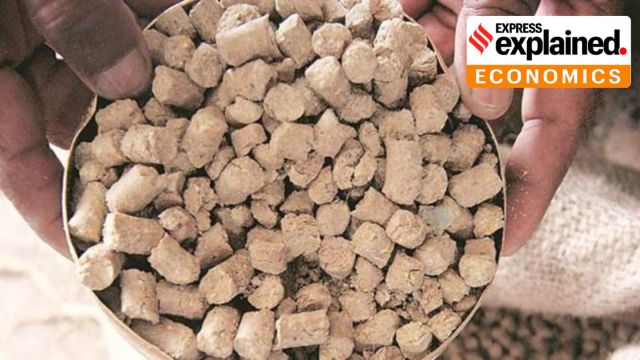Explained: As US eyes India market for farm produce, why these 3 crops are key
Amid the threat of tariffs, the Trump administration is seeking greater market access for American agricultural produce in India. Cotton, corn and soyabean are the three main crops of interest for the US
 The US is a huge exporter of all the three commodities, whose combined shipment value peaked at almost $62 billion in 2022 (Archive)
The US is a huge exporter of all the three commodities, whose combined shipment value peaked at almost $62 billion in 2022 (Archive)The US has three major crops of interest —soyabean, corn (maize) and cotton — when it comes to securing greater market access in India.
The demand for “opening up” could be all the more with US President Donald Trump threatening to impose so-called reciprocal tariffs on Indian exports from April 2: “We will be charging them the same tariffs they charge us”.
The US is a huge exporter of all the three commodities, whose combined shipment value peaked at almost $62 billion in 2022 (see table).
Equally notable is China being the single biggest market for US soyabean and cotton, despite its purchases between 2022 and 2024 falling from $17.9 billion to $12.8 billion for the former and from $2.9 billion to $1.5 billion for the latter.
China was also the largest corn importer from the US at $5.2 billion in 2022, before it plunged to $328 million by 2024. Since 2023, Mexico and Japan have become the top two buyers of US corn.
India — a potential market

It’s against this context that a new report from the US Department of Agriculture’s (USDA) economic research service — titled ‘The Growing Demand for Animal Products and Feed in India’ — makes for interesting reading.
The report projects India’s consumption of animal products — milk, eggs, fish and meat — to increase with rising population and per capita GDP. That would, in turn, drive demand for feed and ultimately the need for substantial imports of ingredients such as corn and soyabean “by the early 2030s”.

India’s domestic corn consumption is expected to climb from 34.7 million tonnes (mt) in 2022-23 to 98 mt in 2040 and 200.2 mt in 2050 under a scenario of “rapid” income growth (6.6% per year). It would go up less — to 62.8 mt in 2040 and 93 mt in 2050 — if income growth is “moderate” at 4.6% per year. Consumption of soyabean meal is likely to similarly go up from 6.2 mt in 2022-23 to 30.9 mt and 68.3 mt for these years under the “rapid” and to 17.7 mt and 28.3 mt under the “moderate” income growth scenarios.
Meeting the higher demand would require imports of 46 mt and 134 mt of corn and 19 mt and 53 mt of soyabean meal in 2040 and 2050 respectively under the “rapid” income growth scenario. If income growth is “moderate”, corn imports will be 11 mt in 2040 and 26 mt in 2050, while correspondingly at 6 mt and 13 mt for soyabean meal.
Simply put, India offers tremendous market potential for American corn and soyabean, even as China reduces its imports or sources more from other suppliers like Brazil and Argentina.
Underlying assumptions
Just for perspective, China imported 112 mt of soyabean, 23.4 mt of corn, 15.9 mt of barley, 8.3 mt of sorghum, 5.5 mt of rapeseed and 9.4 mt of oil meals in 2023-24. Much of these went to meet the feed demand of its humungous swine herd and poultry flock: China has roughly half of the world’s pig population and a fifth of its chickens.
India is nowhere as big an animal products consumer. According to the USDA report, India’s per capita consumption of 82.6 kg in 2020 was way below the 143 kg global average. Even the 82.6 kg was dominated by milk (66.3 kg), followed by fish (7.9 kg), eggs (3.9 kg), poultry meat (2.6 kg), beef (1.1 kg), mutton (0.6 kg) and pork (0.2 kg).
India’s production of animal products has definitely registered impressive average annual growth — of 8.5% for chicken, 5.8% for eggs, 5.1% for bovine meat, 5% for milk and 3.9% for butter/ghee during 2000-22. Only in goat/sheep meat, the 0.8% output growth trailed the average population rise of 1.4% for this period.
The livestock sector’s buoyant growth is also reflected in domestic corn consumption nearly trebling from 12 mt in 2002-03 to 34.7 mt in 2022-23 and quadrupling for feed use (from 5.2 mt to 20.6 mt).
But whether animal products consumption and the derived feed demand will grow to the extent projected by the USDA research report is a moot point. India has so far been a minor importer of feed ingredients. In some years, it did import significant quantities of corn (458,470 tonnes in 2019-20) and soyabean meal/cake (679,843 tonnes in 2021-22). The report estimates total feed consumption at 46.4 mt in 2022. Within that, imports of feed commodities were a mere 178,969 tonnes.
While these volumes are a fraction of China’s, what’s not in doubt is that the US sees India as a large market for its corn and soyabean down the line. India currently levies a 45% basic customs duty on soyabean and 50% on corn imports.
Further, it has restrictions relating to genetically modified (GM) products, which effectively ban imports of corn, soyabean or meal from the US. One wouldn’t be surprised to see the Trump administration pushing for a lifting of these tariff and non-tariff barriers on US corn and soyabean.
Cotton — from exporter to importer
The third crop of interest is cotton, where the US was the world’s No. 1 exporter before Brazil overtook it in 2023-24.
The accompanying chart shows India’s cotton output trebling from 13.6 million to 39.8 million bales between 2002-03 and 2013-14, before steadily declining to a 16-year-low of 29.9 million bales this crop year.
The cultivation of GM cotton hybrids, incorporating genes from the Bacillus thuringiensis or Bt soil bacterium toxic to the American bollworm insect pest, enabled India to emerge as the world’s second biggest producer (after China) and exporter (after US) by 2011-12. Those gains were, however, squandered due to no new GM technologies being approved for commercialisation after 2006 and the existing Bt hybrids turning susceptible to alternative pests, especially pink bollworm and whitefly.
India’s cotton imports for 2024-25 (October-September) are projected at 3 million bales, surpassing its exports of 1.7 million bales that are a far cry from the all-time-high of 13 million bales achieved in 2011-12.
This transformation from a net exporter to importer would, for the US, present an opportunity to ship out more cotton to India. US exports to India were valued at $491.2 million in 2022, $231.2 million in 2023 and $210.7 million in 2024 — which could rise with a 11% duty now on imports of the natural fibre being removed.
The chances of India becoming the biggest market for the US are, perhaps, higher in cotton than in soyabean or corn. And it may be argued that duty-free imports of raw cotton can boost India’s textile and apparel exports to the US itself, which stood at $10.8 billion in 2024.
More Explained
Must Read


EXPRESS OPINION
Mar 30: Latest News
- 01
- 02
- 03
- 04
- 05


























